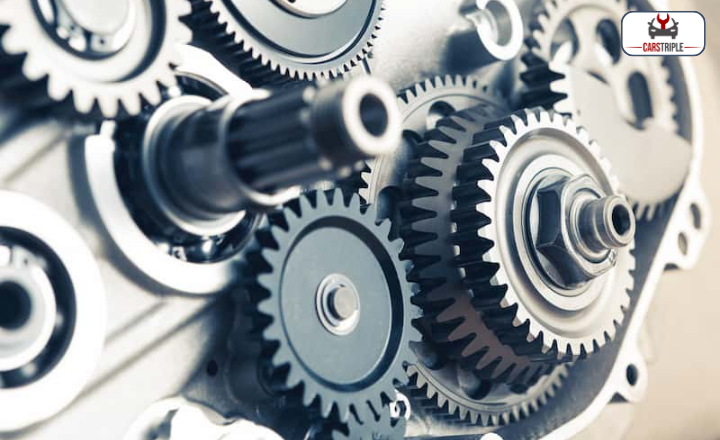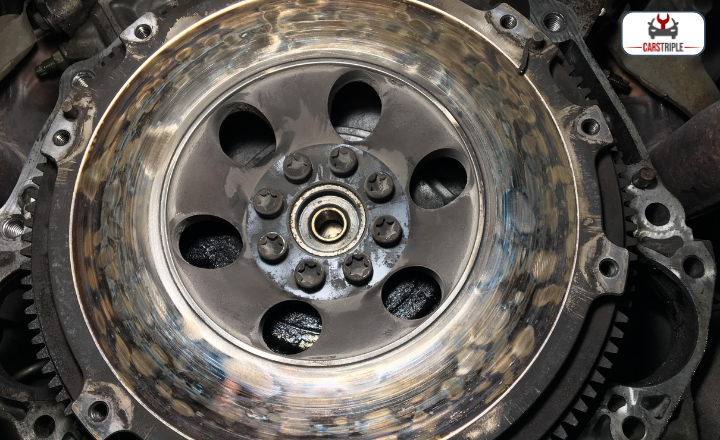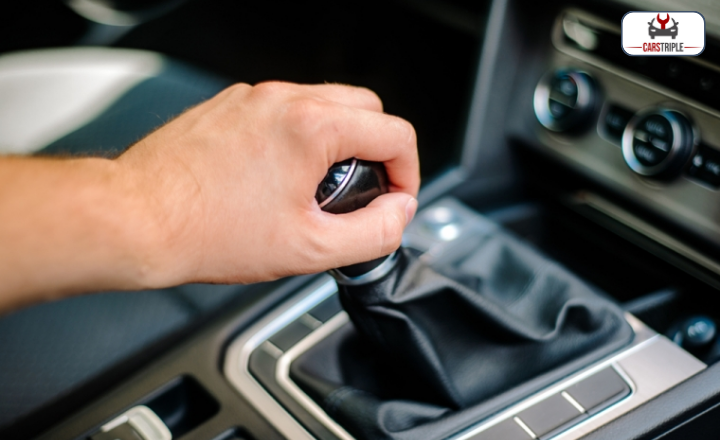This article about the symptoms of a bad flywheel and the replacement cost, we will delve into the mysterious world of flywheels. We’ll learn about their primary functions, warning signs of a failing one, and what it will potentially cost you for a replacement. So get ready for an enlightening journey that might save you from being stranded on the side of the road in the future!
What Is The Purpose Of Flywheels In Automobiles?
The primary purpose of flywheels in automobiles is to maintain the engine’s rotational energy and ensure smooth operation. It acts as a mechanical battery, storing energy when the torque applied is more than needed for work and releasing it when the torque is less. This helps reduce power strokes, and maintaining the crankshaft at the shaft’s constant also plays a crucial role during the startup of an engine.

The gear teeth on its circumference interact with a small Bendix gear to initiate the compression cycle. Once this cycle ends, the Bendix gear disengages, permitting the flywheel to spin freely. These wheels have several vital functions in automobiles. Their primary purpose is to act as a rotational energy storage system.
They store mechanical energy when the engine is running and release it when needed, such as during startup or acceleration. This helps in maintaining consistent engine speed even under varying load conditions. They also help to reduce vibrations and stress on drive train components.
The flywheel’s mass is a damper for engine vibrations, improving ride comfort and reducing wear and tear on other parts. When they are attached to mounts, it reduces the pressure on components such as universal joints, axle couplings, and parallel transmission shafts. These parts often experience angle changes when making turns.
8 symptoms of a bad flywheel
Flywheels don’t last forever and can wear down over time due to regular use in a car. You’ll only notice signs of a worn or damaged flywheel when they’re apparent. If you ignore these signs for too long, they can harm your car’s overall performance.
Here are some usual warning signs that suggest your flywheel might be faulty.
Having trouble starting or starting irregularly

Flywheels also cause trouble starting or starting irregularly. The flywheel’s teeth can become worn or broken over time, which may prevent it from adequately engaging with the starter motor. This could make starting the vehicle difficult or even impossible.
To confirm this issue, you should inspect your starter and flywheel. If the teeth on either part are visibly damaged or missing, they must be replaced. There might also be other issues causing difficulty in starting, like a weak battery, faulty ignition switch, or problems with the fuel system.
Engine Stagnation
An aftermarket flywheel that is too light for your vehicle can cause engine stagnation and stalling. The engine decelerates faster when you remove your foot from the gas or press the clutch. This is due to the lighter flywheel. It lowers the engine’s rotational inertia.
The sudden drop in RPMs can be too quick for the ECU (Engine Control Unit) to compensate by supplying additional fuel and air, resulting in a rough idle or stall.
Flywheel may also need to provide more momentum to keep the engine running smoothly at low speeds, making driving at slow speeds or in stop-and-go traffic more challenging.
Engine Rumbling When the Clutch is Engaged
An uneven flywheel can cause vibrations across the entire powertrain. This could occur if the flywheel is worn out or damaged or needs to be installed correctly. It’s crucial to ensure that all bolts are torque to specifications when changing the clutch, flywheel, or pressure plate.

This engine rumbling could also be a faulty clutch. If the clutch disc is worn or damaged, it may not disengage properly when you press the pedal, causing a rumbling noise. A misaligned clutch can also cause similar issues.
Slippery Elements
When the flywheel slips, it can mimic the feeling of a slipping clutch. This is because the friction surfaces on the pressure plate and flywheel are designed to grip the clutch. Oil or grease on these surfaces can cause a problem. Their function to connect correctly with each other gets disrupted. This can result in them slipping.
The result is that even when the clutch should be fully engaged, it fails to properly grip the flywheel without slipping. This kind of gear slippage can have detrimental effects on your driving experience. A slipping flywheel might be the issue if your equipment keeps dropping. You may notice this when you change gears. Another sign could be that your ground speed isn’t picking up fast enough compared to your engine speed (RPM).
Burning Odor

A burning smell in your passenger cabin could be related to a bad flywheel. The flywheel is an integral part of the clutch system, and excessive or improper usage can lead to overheating due to increased friction. This can result in a burning smell permeating your vehicle.
It’s important to note that this isn’t the only possible cause of such an odor. Other potential culprits include electrical issues, oil leaks, or a stuck brake caliper.
Movement of the Clutch (Clutch Chatter)
Excessive vibration in the clutch pedal can be a symptom of a damaged flywheel. The flywheel may develop excessive runout or distortion due to heat or metal-on-metal wear as time passes. This is particularly likely if you’ve driven your vehicle with an overheated flywheel or worn-out clutch.

The damage to the flywheel can cause it to heat up beyond its operating temperature, leading to a bluish hue and possibly hairline cracks on its surface. You may also observe metal streaks due to repeated heating and cooling cycles. If your car has a spring-loaded (dual-mass) flywheel, the springs could be causing the vibrations.
Improper maintenance
Improper maintenance or incorrect installation of vehicle parts, such as starters or clutches, can damage other components further. Misalignment or inaccurate fitting can cause undue stress on related parts, leading to premature wear and tear. This is why it’s crucial to get replacements done by a professional mechanic who understands the intricacies of these mechanisms.
It’s advisable to replace it promptly if your clutch sustains damage. The longer you wait, the higher the chance that the damage will extend to other parts like the flywheel. The cost of replacing grips is significantly less than replacing a damaged flywheel.
Cannot Change Gears

The transmission system causes problems with changing gears. As you’ve mentioned, the issue could be due to a worn-out flywheel or other damaged transmission parts. It could also be caused by other factors, such as a malfunctioning clutch, low transmission fluid levels, or even a broken gear shifter.
It’s crucial to get your vehicle checked by a professional mechanic immediately if you experience this issue. They can diagnose the exact cause of the problem and suggest the necessary repairs or replacements.
Is It Okay To Drive With A Bad Flywheel?
Driving with a defective flywheel is not recommended due to the potential for further damage to your vehicle. The flywheel plays a crucial role in transmitting power from the engine to your car’s wheels.
If faulty, you may experience increased vibrations, leading to more severe issues like damage to the engine’s crankshaft and clutch components. It could also affect your vehicle’s overall performance and fuel efficiency. It could even lead to complete engine failure if addressed.
Is It Possible To Have It Repaired?
It is possible to have dual-mass wheels and single-mass flywheels repaired, but it largely depends on the extent of the damage. Dual-mass wheels are often replaced due to the potential for interior component damage during grinding procedures. Single-mass flywheels are more amenable to repairs because their surface details can be restored.
Remember that when dealing with these parts, a clutch replacement is also often necessary. This can escalate costs significantly.
How To Replace A Bad Flywheel?
Your flywheel needs to be replaced if it’s broken or damaged. The procedure is easy, but it might require a bit of time. We’re ready to help you learn how to replace a bad flywheel.
- Start by removing the cover of the gearbox. This can be done by loosening and removing the secure bolts and then pulling them out. Once you’ve removed the transmission cover, you can see the flywheel.
- The next step is to remove the flywheel. You can do this by unscrewing and removing its securing bolts. Remember to note where each bolt came from, as they need to go back to their original positions.
- After successfully removing the old flywheel, you can install a new one. The new flywheel comes with its bolts, so you do not need to search for replacements. To install it, reverse the process used in removal.
- After placing your new flywheel, apply torque on its bolts using a torque wrench as specified in your installation guide that came with your new flywheel.
- Finally, put back on the transmission cover once all bolts have been appropriately torqued – repeat earlier steps but in reverse order for this process.
Flywheel Replacement Cost
The cost to replace a flywheel can vary significantly depending on several factors. The make and model of your car are major factors that can influence its price. For instance, luxury or high-performance vehicles may require more expensive parts than standard models.
Labor charges also play a significant role in the overall cost. This depends on where you live and the mechanic’s hourly rate. The quality of the part used for replacement is another factor that can impact the cost. Higher-quality parts are typically more expensive but offer better performance and longevity.
Conclusion
Symptoms of a bad flywheel can lead to various problems, including difficulties in gear shifting, noisy vibrations, and clutch burning smells. Ignoring these symptoms can severely damage your vehicle’s transmission system, leading to costly repairs.
At the first signs of flywheel failure, you must consult a professional mechanic for diagnosis and repair. The cost of replacing a faulty flywheel varies depending on your vehicle model but can generally range from $600 to $900. Timely detection and replacement of a bad flywheel will save you money and ensure your vehicle’s longevity and optimal performance.
FAQ’s
What is a flywheel?
A flywheel is a mechanical device specifically designed to store rotational energy efficiently, contributing to your engine’s smooth operation.
Can I replace the flywheel myself?
Replacing a flywheel requires specialized knowledge and tools; hence, it’s not typically considered a DIY task. It would help if you had this done by a qualified mechanic to ensure proper installation and safety.

